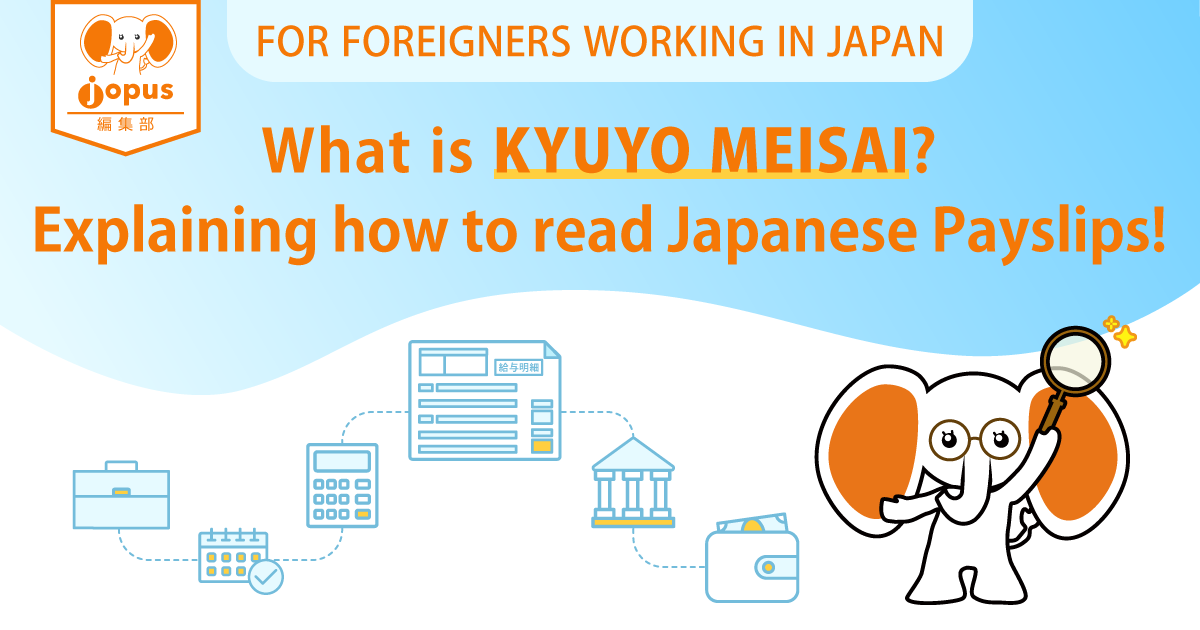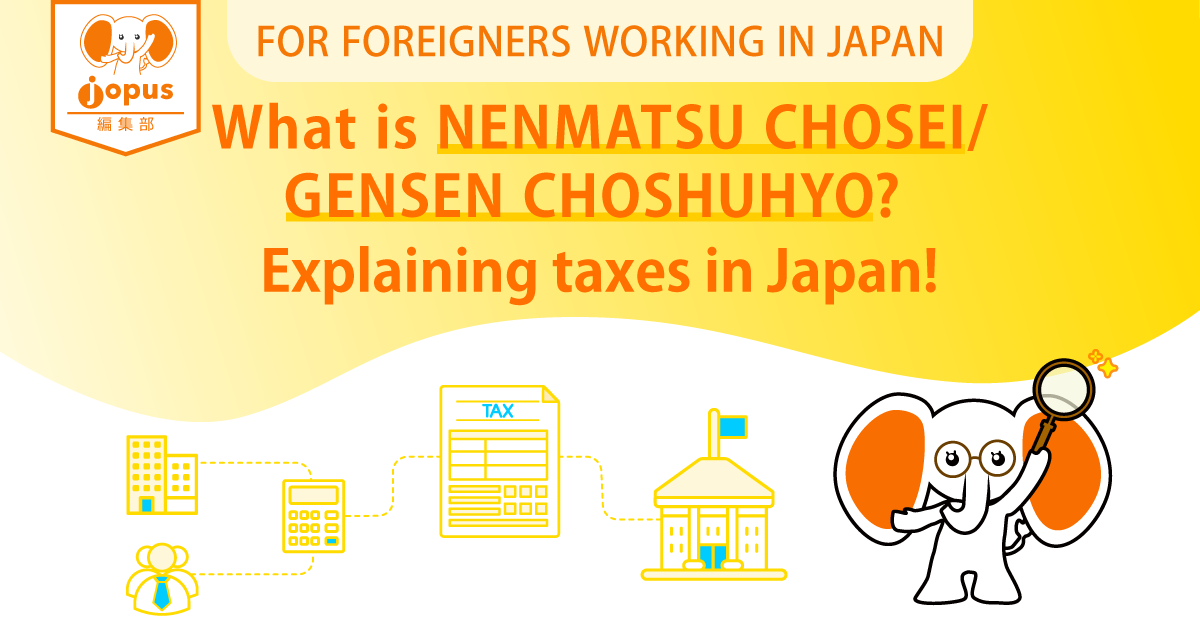There are many items included in your “Kyuyo Meisai” (Payslip), a document you receive from your employer when they pay you a salary. However, you may find it difficult to read or understand it, and may only check the actual amount you will receive. In this article, we will describe how to read Japanese payslips. Understanding a proper way to read payslips will help you to avoid losing your money.
1.What is a payslip?
A payslip is a document that describes items such as your salary, deductions and tax amount. It is generally handed to you by your employer prior to the payment date, and there is a paper version and an electric version which can be viewed on your PC and other devices.
In Japan, companies pay insurance premiums and taxes on behalf of the employee by deducting the amount from the salary. Remember that this is a system for the employees to avoid troubles such as spending too much money or forgetting to pay the tax, by previously deducting insurance premiums and taxes. By deducting the required amount from your monthly salary in advance, you won’t need to conduct payment procedures by yourself such as filing tax returns or paying resident taxes.
1-1.When you receive your payslip
Payslips generally show the correct amount of your salary calculated by the company, but it may be wrong in some cases. Be sure to check your payslip every month that your working hours, benefits and deduction are correct, and that there are no errors in your overtime, certificate benefits, etc., so that you are receiving the correct amount of money. If you are not sure of an item or if you find possible mistakes, you can inform your company to take care of it. When there is a mistake, it is important to contact your company as soon as possible.
1-2.Keeping your payslips
There is no definition about handling the payslips you received, and there is no obligation to keep them. However, we encourage you to keep them for at least two years because they can be used as evidence of your income or tax payment. If there are unpaid salaries, you can claim them as far back as two years. Application for the employment insurance that you need in your career change and resignation is also limited to two years. Keeping your payslips can be viewed as equal to keeping data of your salaries and tax payments.
2.Three categories on your payslips
2-1.Attendance
- Shugyo Nissu(しゅうぎょうにっすう/就業日数):Number of working days in the relevant month as determined by the company
- Shukkin Nissu(しゅっきんにっすう/就業日数): Number of days you worked in the relevant month
- Rodo Jikan(ろうどうじかん/労働時間): Number of hours you worked in the relevant month
- Kekkin Nissu(けっきんにっすう/欠勤日数): Number of days you were absent in the relevant month
- Kyujitsu Shukkin Nissu(きゅうじつしゅっきんにっすう/休日出勤日数): Number of days you worked on legal holidays (one holiday per week in minimum) defined in the Labor Standards Act
- Yukyu Shoka Nissu(ゆうきゅうしょうかにっすう/有給消化日数): Number of acquired paid holidays
- Heijitsu Futsu Zangyo(へいじつふつうざんぎょう/平日普通残業): Overtime exceeded from the working hours stipulated in the employment contract
- Heijitsu Shinya Zangyo(へいじつしんやざんぎょう/平日深夜残業): Working hours between 22:00 and 5:00
- Kyujitsu Rodo Jikan(きゅうじつろうどうじかん/休日労働時間): Overtime on legal holidays stipulated in Article 35 of the Labor Standards Act
- Chikoku Sotai Jikan(ちこくそうたいじかん/遅刻早退時間): Number of late arrival and early departure hours in the relevant month
- Yukyu Zan Nissu(ゆうきゅうざんにっすう/有給残日数): Number of remaining paid holidays as of the closing period of the relevant month
2-2.Payment
- Kihon Kyu(きほんきゅう/基本給): Base amount of salary paid by the company
- Yakushoku Teate(やくしょくてあて/役職手当): Varying benefits depending on the position
- Shikaku Teate(しかくてあて/資格手当): Benefit paid to employees when they try or acquire qualifications
- Jutaku Teate(じゅうたくてあて/住宅手当): Benefit that the company pays a part of the employee’s house rent or loan
- Kazoku Teate(かぞくてあて/家族手当): Benefit that company pays a certain amount to employees with spouses or children
- Tsukin Teate(つうきんてあて/通勤手当): Benefit for the commuting transportation fee
- Zangyo Teate(ざんぎょうてあて/残業手当): Benefit for overtime work exceeding the ones specified in the employment contract
- Shinya Kinmu Teate(しんやきんむてあて/深夜勤務手当): Benefit for employees who work between 22:00 and 5:00
- Hotei Kyujitsu Teate(ほうていきゅうじつてあて/法定休日手当): Special benefit for working on legal holidays (one holiday per week in minimum) defined in the Labor Standards Act
2-3.Deductions
- Koyo Hokenryo(こようほけんりょう/雇用保険料): Insurance premiums to receive unemployment benefits and childcare leave benefits
- Shakai Hokenryo(しゃかいほけんりょう/社会保険料): Public insurance premiums such as health insurance, employees’ pension insurance, employees’ pension fund and nursing-care insurance
- Shotoku Zei(しょとくぜい/所得税): Taxes based the salary of the year
- Jumin Zei(じゅうみんぜい/住民税): Regional tax based on the previous year’s income
- Kyosaihi(きょうさいひ/共済費): Monthly deposit fees for company travels and recreational expenses
3. Summary
Your salary is important because it reflects your hard work as a number. Although there should be no mistakes in your salary payment, it is impossible to say they are error-free as they are processed by human hands. Payslips are evidence to define your income and tax amount. Make sure you check your payslips every month when you receive them, not leaving them unchecked.
Learning Japanese
Business Japanese
List of ways to look for jobs in Japan
- Recruitment Agency for Expats in Japan
- Job Board for Expats in Japan
- Search for jobs by occupation in Japan
- Search for jobs by industry in Japan
Job Hunting Guide for International Students
jopus編集部
Latest posts by jopus編集部 (see all)
- 【Osaka】Corporate sales of trading companies - 11/18/2021
- 【Jopus Connecter】Web Engineer Job List - 11/1/2021
- 【October 26】Jopus Connecter version 0.3.5 Release Notes - 10/26/2021


















